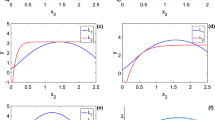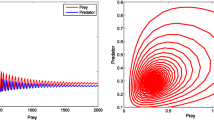Abstract
Various field and laboratory experiments show that prey refuge plays a significant role in the stability of prey–predator dynamics. On the other hand, theoretical studies show that delayed system exhibits a much more realistic dynamics than its non-delayed counterpart. In this paper, we study a multi-delayed prey–predator model with prey refuge. We consider modified Holling Type II response function that incorporates the effect of prey refuge and then introduce two discrete delays in the model system. A negative feedback delay is considered in the logistic prey growth rate to represent density dependent feedback mechanism and a positive feedback delay is considered to represent the gestation time of the predator. Our study reveals that the system exhibits different dynamical behaviors, viz., stable coexistence, periodic coexistence or chaos depending on the values of the delay parameters and degree of prey refuge. The interplay between two delays for a fixed value of prey refuge has also been determined. It is noticed that these delays work in a complementary fashion. In addition, using the normal form theory and center manifold argument, we derive the explicit formulae for determining the direction of the bifurcation, the stability and other properties of the bifurcating periodic solutions.










Similar content being viewed by others
References
Alstad D (2001) Basic populations models of ecology. Prentice Hall Inc., Upper Saddle River
Anderson O (1984) Optimal foraging by largemouth bass in structured environments. Ecology 65:851–861
Anderson TW (2001) Predator responses, prey refuges and density-dependent mortality of a marine fish. Ecology 82(1):245–257
Johnson WD (2006) Predation, habitat complexity and variation in density dependent mortality of temperate reef fishes. Ecology 87(5):1179–1188
Jana D, Ray S (2016) Impact of physical and behavioral prey refuge on the stability and bifurcation of Gause type Filippov prey–predator system. Model Earth Syst Environ 2:1
Lima SL, Dill LM (1990) Behavioral decisions made under the risk of predation: a review and prospectus. Cana J Zool 68:619–640
Bell SS, McCoy ED, Mushinsky HR (1991) Habitat structure: the physical arrangement of objects in space. Chapman and Hall, New York
Lima SL (1998) Stress and decision making under the risk of predation: recent developments from behavioral, reproductive, and ecological perspectives. Adv Study Behav 27:215–290
Brown JS, Kotler BP (2004) Hazardous duty pay and the foraging cost of predation. Ecol Lett 7:999–1014
Caro T (2005) Anti predator defenses in birds and mammals. University of Chicago Press, Chicago
Stankowich T, Blumstein DT (2005) Fear in animals: a meta-analysis and review of risk assessment. Proc R Soc Ser B 272:2627–2634
Cooper WE Jr (2009) Theory successfully predicts hiding time: new data for the lizard Sceloporus virgatus and a review. Behav Ecol 20:585–592
Luckinbill LS (1973) Coexistence in laboratory populations of Paramecium aurelia and its predator Didinium nasutum. Ecology 54:1320–1327
Ray S, Straškraba M (2001) The impact of detritivorous fishes on the mangrove estuarine system. Ecol Model 140:207–218
Roy M, Mandal S, Ray S (2008) Detrital ontogenic model including decomposer diversity. Ecol Model 215:200–206
Sih A et al (1985) Predation, competition, and prey communities, a review of field experiments. Ann Rev Ecol Syst 16:269–311
Savino JF, Stein RA (1982) Predator–prey interaction between largemouth bass and bluegills as influenced by simulated, submersed vegetation. Trans Am Fish Soc 111:255–266
Kar TK (2005) Stability analysis of a preypredator model incorporatinga prey refuge. Commun Nonlinear Sci NumerSimul 10:681691
Jana D (2013) Chaotic dynamics of a discrete predator–prey system with prey refuge. Appl Math Comput 224:848–865
Jana D (2014) Stabilizing effect of Prey refuge and Predator’s interference on the dynamics of Prey with delayed growth and generalist Predator with delayed gestation. Int J Ecol 2014(429086):12. doi:10.1155/2014/429086
Jana D, Agrawal R, Upadhyay RK (2015) Dynamics of generalist predator in a stochastic environment: effect of delayed growth and prey refuge. Appl Math Comput 268:1072–1094
MacDonald M (1989) Biological delay systems: linear stability theory. Cambridge University Press, Cambridge
May RM (1981) Theoretical ecology: principles and applications. Blackwell Scientific Publications, Oxford
XiaoD Ruan S (2001) Multiple bifurcations in a delayed predator-prey system with nonmonotonic functional response. J Differ Equ 176:494–510
Bairagi N, Jana D (2011) On the stability and Hopf bifurcation of a delay-induced predator–prey system with prey refuge. Appl Math Model 35:3255–3267
Jana D, Agrawal R, Upadhyay RK (2014) Top-predator interference and gestation delay as determinants of the dynamics of a realistic model food chain. Chaos Solitons Fractal 69:50–63
Yan XP, Chu YD (2006) Stability and bifurcation analysis for adelayed Lotka–Volterra predator–prey system. J Comput Appl Math 196:198–210
Song Y, Peng Y, Wei J (2008) Bifurcations for a predatorprey systemwith two delays. J Math Anal Appl 337:466–479
Nakaoka S, Saito Y, Takeuchi Y (2006) Stability, delay, and chaotic behavior in a Lotka–Volterra predator–prey system. Math Biosci Eng 3:173–187
Xu C, Liao M, He X (2011) Stability and Hopf bifurcation analysis for a Lotka–Volterra predator–prey model with two delays. Int J Appl Math Comput Sci 21(1):97–107
Liao M, Tang X, Xu C (2012) Bifurcation analysis for a three-speciespredator preysystem with two delays. Commun Nonlinear Sci Numer Simulat 17:183–194
Jana D, Pathak R, Agarwal M (2016) On the stability and Hopf bifurcation of a prey-generalist predator system with independent age-selective harvesting. Chaos Solitons Fractal 83:252–273
Yang R, Wei J (2014) Stability and bifurcation analysis of a diffusive prey–predator system in Holling type III with a prey refuge. Nonlinear Dyn 79(1):631–646
Yang R, Zhang C (2016) Dynamics in a diffusive predator–prey system with a constant prey refuge and delay. Nonlinear Anal Real World Appl 31:1–22
Yang R, Zhang C (2016) The effect of prey refuge and time delay on a diffusive predator–prey system with hyperbolic mortality. Complexity 50(3):105–113
Freedman HI (1987) Deterministic mathematical models in population ecology. HIFR Consulting Ltd., Edmonton
Kuang Y (1993) Delay differential equations with applications in population dynamics. Academic Press, New York
Yang X, Chen L, Chen J (1996) Permanence and positive periodic solution for the single species nonautonomous delay diffusive model. Comput Math Appl 32:109–116
Butler G, Freedman HI, Waltman P (1986) Uniformly persistent systems. Proc Am Math Soc 96(3):425–430
Freedman HI, Waltman P (1984) Persistence in models of three interacting predator–prey populations. Math Biosci 68:213–231
Freedman HI, SO J (1985) Global stability and persistence of simple food chains. Math Biosci 76:69–86
Brauer F, Chavez CC (2001) Mathematical models in population biology and epidemiology. Springer, New York
Gaurd TC, Hallam TG (1979) Persistence in food web-I. Lotka–Voltera chains. Bull Math Biol 41:877–891
Ruan S, Wei J (2003) On the zeros of transcendental functions with applications to stability of delay differential equations. Dynam Contin Discret Impuls Syst 10:863–874
Hassard BD, Kazarinoff ND, Wan YH (1981) Theory and application of Hopf bifurcation. Cambridge University, Cambridge
Gopalsamy K, He X (1994) Delay-independent stability in bi-directional associative memory networks. IEEE Trans Neural Netw 5:998–1002
Acknowledgments
M. Lakshmanan acknowledges National Academy of Sciences, India for financial support in the form of a Senior Scientist Platinum Jubilee Fellowship.
Author information
Authors and Affiliations
Corresponding author
Rights and permissions
About this article
Cite this article
Jana, D., Gopal, R. & Lakshmanan, M. Complex dynamics generated by negative and positive feedback delays of a prey–predator system with prey refuge: Hopf bifurcation to Chaos. Int. J. Dynam. Control 5, 1020–1034 (2017). https://doi.org/10.1007/s40435-016-0267-5
Received:
Revised:
Accepted:
Published:
Issue Date:
DOI: https://doi.org/10.1007/s40435-016-0267-5




